Shipping Container Homes & Corrosion (Rust) Issues
A free White Paper from the World’s Leading Provider of Design and Education Resources on Container based Construction.
This paper highlights a 5 year old container based structure located in an aggressive Ocean side environment already showing near catastrophic corrosion damage resulting from poor pre-construction container preparation and inadequate ongoing preventative maintenance.

This White Paper is intended as an appendix to Tutorials 2, 3 and 9 in our Video Tutorial Series which are free for our Members.
Video 2: Anatomy of a Shipping Container
Video 3: What to look out for when purchasing a Second hand Container
Video 9: Burying Shipping Containers Underground.
Download the White Paper as a PDF Document here.
White Paper – Shipping Container Homes and Corrosion ( Rust ) Issues
We recommend right clicking on the link and then saving the file to a folder on your computer. Save the document into a folder you will remember the name of and then open it when it’s fully downloaded rather than trying to view it in your browser – the file is approx 22 MB in size.
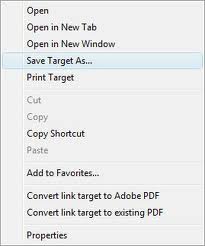
Find out more about Site Membership here.
White Paper in Text Format.
There are many popular myths and misunderstandings about Container based Construction but none of the often quoted misunderstandings are nearly as pervasive amongst Industry Professionals – Architects, Building Designers, Contractors etc as the idea that Shipping Containers are made from some special, virtually indestructible steel that will not rust like regular structural steel and as such warrants little concern or consideration regarding pre-construction preparation or ongoing preventative maintenance for corrosion management.
Cor-Ten Steel
The primary construction material for Type 1A GP or General Purpose and Type 1A HC or High Cube Containers, the two container types most commonly used in Container based Construction is of course Cor-Ten Steel – also sometimes called “Weathering Steel”
Quite bluntly this often quoted statement that Containers don’t suffer from corrosion issues because they are manufactured using Cor-Ten Steel simply isn’t true.
The truth is that Cor-Ten Steel is a high strength, low alloy structural Steel using copper, chromium, silicon and phosphorus as alloys – and this alloy under the right conditions displays a much greater level of resistance to corrosion when compared with unalloyed steels.
Technical Notes
The comparison of Cor-Ten to the ASTM grades can loosely be stated as Cor-Ten A is equivalent to ASTM A242 and Cor-Ten B is equivalent to ASTM A588 Grade A.
Type 1A ISO Shipping Containers are typically constructed from Cor-Ten B Steel
Cor-Ten A and B both meet or exceed the requirements of ASTM A606 Type 4.
Of course as with any real world discussion the keywords in this statement are highlighted as under the right conditions.
This building was constructed from 3 x 40’ GP Type 1A Containers and 1 x 20’ GP on the Island of Phuket in Southern Thailand in 2007.
After just five years the structure is already displaying major corrosion damage resulting from incorrect pre-construction preparation of the Containers and inadequate ongoing preventative maintenance in a high salt laden coastal environment.
It’s not widely understood that Cor-Ten Steel is actually very sensitive to salt-laden air environments – See notes below.
Secondly using Cor-Ten Steel in construction presents a number of challenges. Cor-Ten is not rustproof in itself and if water is allowed to accumulate in pockets as has occurred in many places here those areas will experience high corrosion rates on par with regular ASTM grade steel.
Great care must be taken for provision for drainage in the building design when using Cor-Ten Steel.
Photographs showing typical detail damage to Structure after 5 Years.
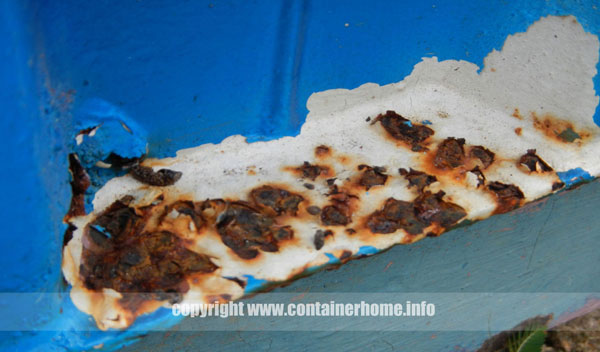
Bottom Side Rail – 1.6mm wall sheet steel is fully penetrated in many places.
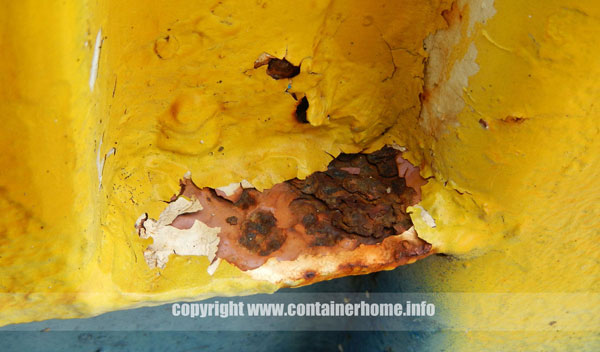
Bottom Side Rail
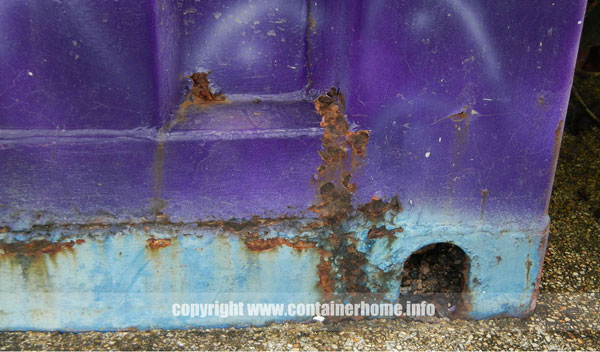
Shipping Container Home Foundations must be designed correctly. In the authors opinion Containers should not be simply placed on a slab on grade foundation such as shown here.
Shipping Container Homes Foundation Video Here – Video is Free for Members.
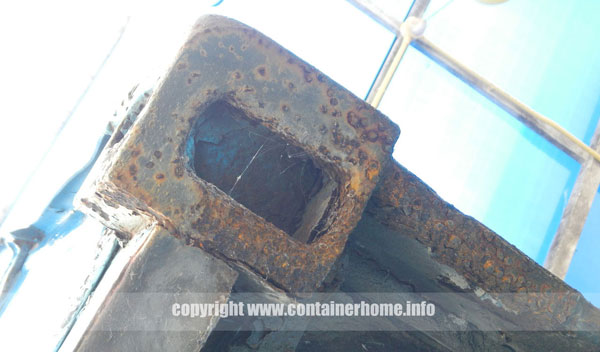
Looking up under Bottom Right Front ISO Corner Fitting of 2nd Story Container
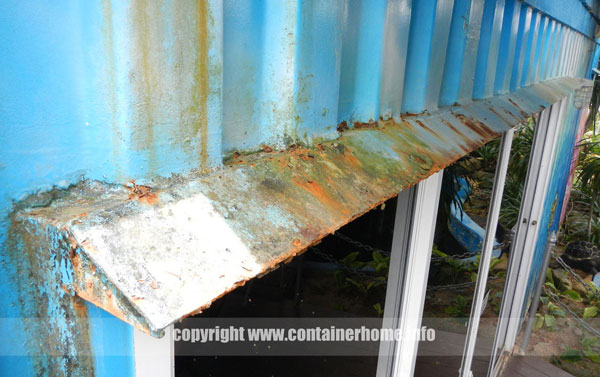
Now I think it’s reasonable to say that Thailand in general doesn’t have a reputation for high quality building practices or preventative maintenance process and additionally this building is located in an exposed coastal area on the Island of Phuket.
So it is accepted that this is an extreme case, but that tends to be the nature of case studies – both good and bad – they tend to highlight the margins rather than the average.
The real purpose of including these images here is graphically demonstrate the Issue of Shipping Container Homes and Corrosion ( Rust ) is very real and it deserves far more serious consideration that the subject gets today.
Just how vulnerable Type 1A Containers can be to corrosion issues is perhaps best put in perspective by revealing that the standards governing container manufacture state that a manufacturer must guarantee that a container will remain corrosion free for a period of 3 years – although I have seen some 5 year guarantees from some manufacturers.
Corrosion in this context is defined as rusting which exceeds a particular European Scale of degree of Rusting on at least ten percent of the total container surface, excluding that resulting from impact or abrasion damage.
Now don’t get me wrong that is an impressive feat given the extreme environment under which most containers operate under but a 3 to 5 year corrosion guarantee – excluding areas affected by physical damage is a LOT less than most people would expect from a product with the corrosion proof reputation of Shipping Containers.
Cor-Ten steel’s corrosion resistance comes from its chemical composition that actually promotes the early formation of a protective oxide layer ( in laymans terms that really just means rust layer ) once its been formed this oxide layer protects the underlying material from further corrosion by controlling the rate at which oxygen in the atmosphere can react with the surface of the metal.
When compared with Cor-Ten Steel non-weather-resisting steels have a relatively porous oxide layer which will in turn hold moisture which will of course then promote further corrosion.
In the case of ordinary steel after a certain amount time this rust layer will delaminate from the surface of the metal, exposing the material underneath in turn causing even more damage.
However the rust layer on Cor-Ten steel is not as porous because it adheres more firmly to the base metal. The rate of corrosion initially progresses at about the same rate as ordinary steel, but it soon begins to level out and under the right conditions it stabilizes and becomes virtually maintenance free.
Considered aesthetically pleasing by some people this finish has become quite popular with many high profile architects over the last 20 years and has been specified and used in a wide variety of construction applications including building facades, architectural sculptures and even bridges
Cor-Ten steel was developed in the 1930’s by US Steel – primarily for use in railway coal wagons and the same attributes that gained it favor in this original application was what saw Cor-Ten later adopted for use in ISO shipping containers.
Now this corrosion resistance is of course a tremendous asset and a benefit that we can take advantage of – however there are several requirements that must be adhered to in order to ensure the material performs as intended and the greatest threat to its corrosion resistance performance is what is referred to as the wetting and drying cycle.
The wetting and drying cycle is basically the simple concept that the surface of the steel when it gets wet must be allowed to dry out.
Ideally, to weather in the expected fashion, corrosion resistant steel needs to under go both wetting and drying cycles. This is because moisture activates the corrosion process but, with the drying, the oxide layer it creates obtains its nonporous state. The more rapid the wet-dry cycle, the more even the oxide layer that is created in the process.
Continuous dryness is perhaps quite obviously not a problem whereas continuous wetness can be a really big problem for corten steel.
Design considerations and Cor-Ten steel.
Designing in Cor-Ten steel with a view to maximizing its corrosion resistant properties is primarily concerned with ensuring anything that retains moisture is discouraged – and – in an interesting counter intuitive twist this includes salt.
The very nature of salt adversely affects the ‘patina’ as it is called as it maintains a continuously damp environment on the metal surface and as a general rule of thumb unprotected weathering steel should not be used within 1 – 2km of the coastline.
This is counterintuitive of course because as “Shipping Containers” ISBU’s are virtually permanently exposed to these conditions and hence the very real world issue of containers being affected by corrosion and the earlier mentioned 3 – 5 years guarantee requirement.
In these challenging environments additional protection is gained by the application of protective paint coatings applied to the containers
The requirements of painting Cor-Ten Steel doesn’t really differ from that of normal grades of steel. One significant advantage that occurs from painting Cor-Ten steel however is that damage to the paint does not typically result in what we call under-creep corrosion to the surrounding painted area.
So lets take a moment to summarize our new understanding of Cor-Ten Steel and explore what it all means for those interested in ISBU based construction.
1, Corten steel is corrosion resistant when compared to unalloyed steels.
2, Corrosion is a big issue with Shipping Containers, its a major consideration that is built into every detail of the design of Shipping containers themselves by factory engineers.
3, You must carefully inspect second hand containers for corrosion issues prior to purchase and the most likely places to have corrosion issues are the places that people tend not to look – specifically underneath the floor subassembly where the container has been in regular contact with moisture from the ground.
Just remember corrosion is not the only pre-purchase inspection requirement and there is more on what to look for – and look out available in Tutorial 3 of 15 How to purchase Second Hand Containers.
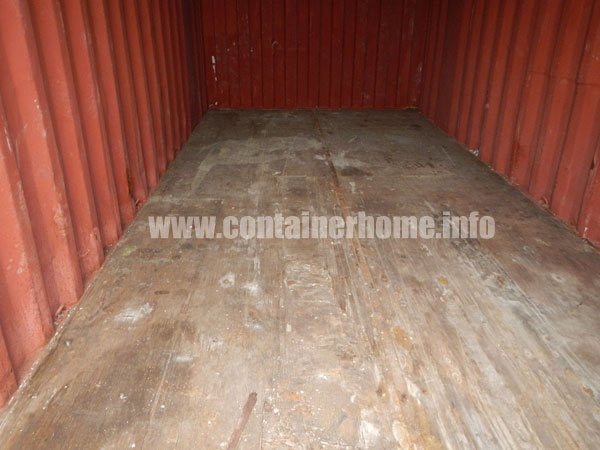
This is a photograph of a 40’ Type 1A GP Container that had been partially refurbished for sale. A first glance it looks to be in fair condition but just as with buying a second hand car you must look under the “bonnet”
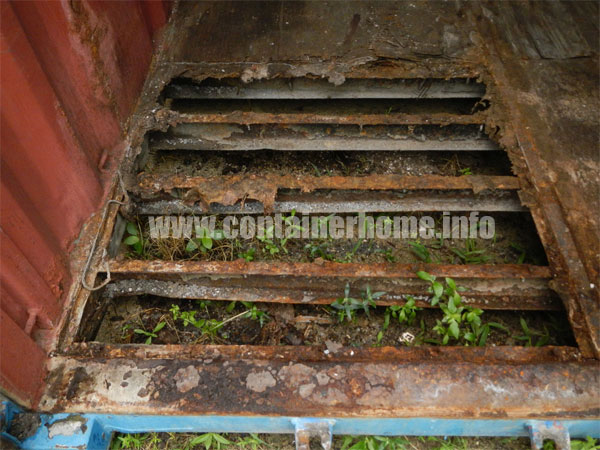
Same Container with a section of the floor removed – As you can see an Container that superficially looks to be in fair condition can hide major issues.

4, When using containers in a non intended purpose such as ISBU based construction you must take care to avoid creating crevices and water or dirt traps by virtue of your design or any modifications you make.
This is particularly relevant where we join two containers together and create a possible water or dirt trap at the location of the join – anywhere that can collect fallen leaves or even the growth of moss can also adversely affect Cor-Ten steels corrosion resistance performance.
5, When working with containers connections to dissimilar materials, such as when using zinc or cadmium plated bolts should be avoided whenever possible – all fasteners where practical should also be made of weathering steel or stainless steel.
It is possible to use galvanized or plated steel fixings providing they are isolated from the surface of the weathering steel.
6, When welding specific low alloy welding rods should be used
7, All wet environments, immersed or buried conditions are unsuitable for weathering steels.
They provide technical drawings, presentation plan sets, video tutorials and whitepapers all free of charge to our members as well as the only 3D Design Software specifically developed to assist in the design and pre construction visualization of Container based structures.
If you have any questions about this or any of the other publications or resources please address your enquires to admin@containerhome.info
This free material is provided as sample content from ContainerHome.info It is our hope that some visitors will appreciate the style and format of the information we provide and choose to become a member of the paid section of our site. Find out more about site membership here.

